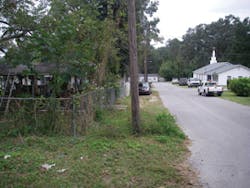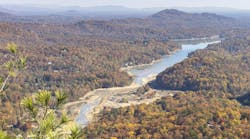Project Profile- Socio-Economic Benefit of a Stormwater Project: Lincoln Gardens Neighborhood
Alachua is an Indian word meaning sink. It depicted the layout of the land. Nestled beneath huge live oaks, magnolias, cedars, and hickory trees, the town of Alachua is steeped in Florida history dating back to the Spanish explorers who were looking for land for their cattle ranches. The DeSoto trail winds through the area and can be followed by those interested in Indian and Spanish culture. On April 12, 1905, the city of Alachua was officially incorporated and had a population of 526 people.
Today, Alachua has a population of approximately 6,800 people, a diverse economic structure, and a picturesque Main Street straight out of the 1950s. Small family-owned shops are nestled along the serpentine street that is adorned with ever changing foliage of the Bradford Pear tree.
The developments that came in the 1950s included Lincoln Gardens, a residential subdivision. Platted in 1956, Lincoln Gardens is located in the northeast section of Alachua. The 108-lot subdivision on 19 acres was situated on the side of a hill that ranged from elevation 140 feet NGVD to 90 feet NGVD over 676 feet, or a slope of 7.4%. Once Lincoln Gardens was developed, the streets and lots became the conveyance systems for the runoff from the top of this hill. No defined drainage was designed as part of the subdivision. This development occurred when there was no regulation of stormwater in Alachua County, and therefore the stormwater standards that we recognize today were not required.
As the lots were developed and a commercial facility was placed at the top of the hill, the runoff rate and volume increased. This increase in impervious surfaces in the watershed started to affect the residents in Lincoln Gardens by flooding their yards and causing erosion. Although no documentation of structural damage was recorded, flooding was noted to come up to the doorsteps of many of the homes. In the 1990s, the city applied for a Community Development Block Grant (CDBG) to improve the drainage in the neighborhood. The grant funded the construction of curbs and gutters on the south side of most streets and the installation of inlets to convey the runoff.
Forty-eight years after the subdivision was platted, two major tropical systems passed over the area in 2004. Hurricanes Frances and Jean caused flooding throughout the city of Alachua and had severe impacts to the Lincoln Gardens subdivision. Because of this flooding in Lincoln Gardens, the city applied for a Federal Emergency Management Agency (FEMA) Hazard Mitigation Grant Program (HMGP) grant to again improve the drainage within the subdivision. The HMGP grant funded the construction of curbs and gutters on the remaining northside streets in the neighborhood and the installation of additional inlet structures. The grant also funded the sodding of the right of way to help stabilize the erosion problems.
To gain support for this project from the Lincoln Gardens neighborhood, the city conducted a number of public information events that included a neighborhood workshop with city staff; Causseaux, Hewett, & Walpole; and the contractor, Art Walker Construction. The purpose of the meetings was to explain upcoming drainage improvements planned for the neighborhood and to advise residents on the construction schedule. This and other collaborative efforts by the city helped to build cooperation during this project.
The Lincoln Gardens neighborhood is a low- to moderate-income neighborhood that has experienced neglect over time. Trash, debris, and abandoned cars lined the streets. Because the streets were not curbed, residents had no choice but to drive and park within the right of way, killing the grass and perpetuating the erosion problems. This simple drainage project became the stimulus for a neighborhood cleanup and a change in the use of the right of way. Trash and debris were removed from the right of way, parking was directed into existing driveways and along the streets, and the grass began to grow. As a few neighbors took the effort to clean up and landscape their yards, other neighbors took notice and began to do the same throughout Lincoln Gardens.
Throughout the construction, the residents of Lincoln Gardens were very cooperative with the contractor. Neighbors worked with the contractor to remove the debris along the right of way and coordinated with driveway closures. This cooperative spirit helped the contractor complete the required work within two months. The sight of new grass in the right of way caused many of the residents to add sod to their yards. Many of the residents took advantage of the contractor’s cost for sod by purchasing the sod through the contractor.
The results of the HMGP project not only improved the drainage in the Lincoln Gardens neighborhood but also changed the neighborhood in other ways. The community bonded together to assist in the improvement of their neighborhood. This small neighborhood drainage project has managed to build the community from a “forgotten eyesore” to a living neighborhood whose residents care about its appearance. The intent of the project was to control erosion and to reduce flooding in the neighborhood; the results were not only reduced erosion and flood relief, but also the reestablishment of a community in Lincoln Gardens. This is something that engineers cannot design, but happens as a result of pride and cooperation. The greening of a small strip within the right of way turned into a total greening of a neighborhood.

